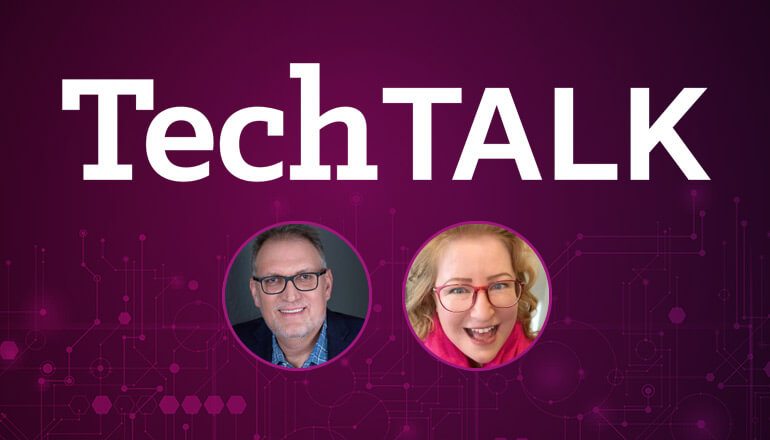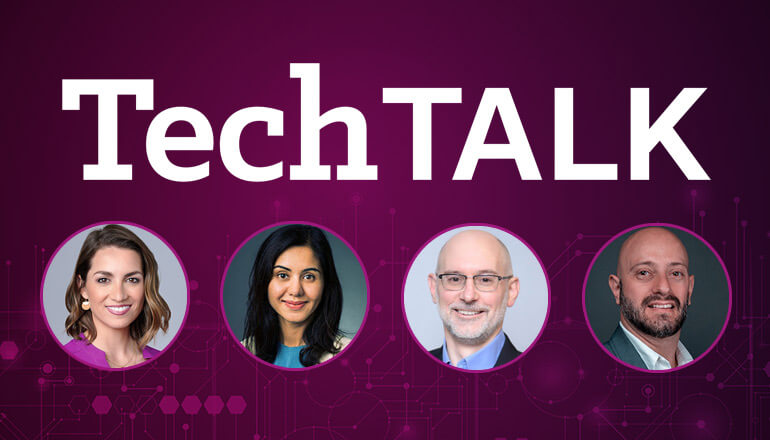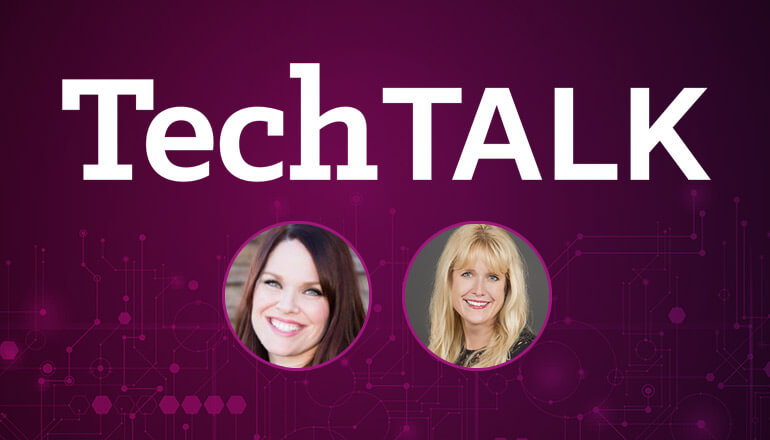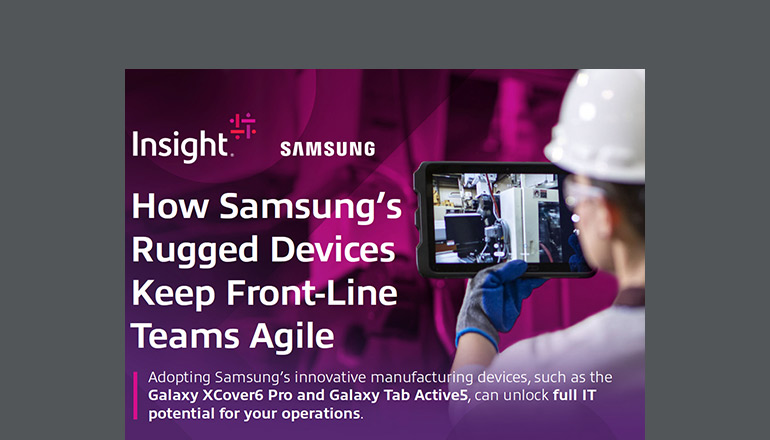Audio transcript:
Mission-Critical Technology: How Samsung Is Transforming Public Sector IT
Z
Hello, welcome to another exciting episode of Insight TechTalk. My name is Z Tinoco, and today I am joined by Kate Kelley, senior channel manager with Samsung. We're going to talk about the public sector and how Samsung and Insight are a good choice. Now, the public sector is actively seeking partners and technology that is reliable, secure, and can easily ramp up and deploy. So with that, we're going to dive into some good questions that you can ask and be aware about. So with that, Kate, welcome to Insight TechTalk.
Kate
Thank you for having me, again.
Z
Well, again, yes, I know we did an episode not that long ago, So I'm super excited.
Kate
We did. Happy to be back.
Z
Now, today we're talking about public sector. Now, I love this topic because Samsung is a brand that I really enjoy, and I see everywhere, right?
Kate
As Insight is our favorite.
Z
Definitely, right, great partnership.
Kate
I can say that.
Z
Now, in the consumer world, right, in the everyday world, Samsung is well known when it comes to devices, televisions, and even appliances. But what we don't know is how does Samsung actually play in the public sector space? Can you give us some examples?
Kate
Absolutely, so Samsung decided to focus on our, what we call our Fed Five. It's a marketing strategy, but really what we can look at is saying, here's our speeds and our feeds of our devices, and, you know, these are quality, quality products, but at the end of the day, really it is the solution that drives it, looking at it and saying, how are these use cases relevant within the federal government? And so the first one that we came up with is our Tactical Edition. A little history on the Tactical Edition is that when we had a device that launched, we had to go through creating a custom ROM for this device. It cost a lot of money, and it took a lot of time. So Samsung wanted to be very proactive, but also build that trust along with the federal government. So we built that side by side with the government and said, "What do you need to be able to easily be deployed "to federal governments or federal employees?" And so what we've done is we've pre-installed the necessary drivers that they need for, for example, third-party peripherals, you know, night vision goggles, antennas, even printers, right? So it's ready to go once it is received within the employee, or the soldier or employee. In the Tactical Edition, you know, we look at it a lot as a soldier solution, 'cause a lot of our soldiers at war are using 'em, but we also can use 'em for our police officers that are inside of schools that are able to use the devices, ready to go right from the other one.
The second solution that we have is what we call our situational awareness. This is utilizing a software that the government created called ATAK, A-T-A-K. And we basically built what we call an assist kit. So really what it does is it's making sure that you are able to locate the assets that you're trying to track. We've actually put 'em on K-9 officers, onto the dogs, so we can see exactly where they're going. But we've also put 'em on soldiers. So the soldiers, when they're dropped out of a airplane, they can stand there and they can look and they can say, this way is the good guys, this way is the bad guys. Don't go that way, right? But also another thing we can do is tap into things like CCTV for our schools. So if there's an active shooter, you're able to determine, you know, where are the good guys and where are the bad guys? So it's not just at war, but it's also on our homeland.
Z
Yeah, so there goes that definitely the deployment part is pretty prevalent there, right, an example you gave that not only are we going to give you the devices that you need or the technology, but it's already has the equipment and the things that are going to set you up for success in whatever field you're in, but then the last thing of course, then it answers the security piece, right? Like, where is everybody at and how can we guide and direct people to safety, right, more than anything, which kind of goes in hand, not only are we, have safety of the devices and make sure that we know where they're at and the assets, but also the safety of the person using it, which is, I mean, so critical nowadays.
Kate
Absolutely, absolutely. And then a couple of the other ones that we have, we have compliance monitoring. This is a really great one. We have a couple use cases on that one as well. The first one that I thought was pretty cool was when we had a influx of refugees, and we had these massive camps with, you know, hundreds of thousands of people, and to be able to track them, we actually gave them our Samsung devices, so they would be able to go around and not basically have to stand in line waiting for their name to be called, so we would be able to contact them and we can also make sure that they're in compliance, right, they're still there, they're still, you know, by using biometric scanning. But it also gave them the ability to be on the internet, contact loved ones back home. Another one, another compliance one that I find extremely important is saving the lives of our CPS workers, so that's a really good use case that we've had, where they're going into a very dangerous situation, we want to make sure that they get out safely. And so instead of just saying, "I got," you know, "I'm back in my car, I'm safe," we're actually using biometric scanning of the face to say, this is me, I'm good, and I am safe. Another one that we have is our DeX in-vehicle. So DeX is desktop-like experience, and what that is is it basically takes the phone and it turns it into a mini computer, a mini laptop, PC, where you plug it in and it's hooks to a keyboard and it hooks to a monitor, inside of the police officer's car. And so it's able to take all the information that they need to work on a day-to-day basis, but it's in a handheld form, but projected up onto a computer screen. And then when they leave the vehicle, all they do is take the device out and then now, it's on their person, then we tap into that situational awareness piece into there as well.
But we have this actually deployed with Chicago PD, LAPD, Detroit PD, so we're branching out into all these different police departments to also ensure our police officers safety. The last one that we have is, I think really very cool, it's kind of "Mission: Impossible"-ish type like, but it's called our, it's our Secure Spaces. So we partner with a company called Privoro. And Privoro, what they've done is they understand that there is a need for devices to be able to go into classified rooms. So what is happening is we have people going into these classified meetings and they do not have their phones with them, so what they need is they need to have admins constantly coming in and keeping them updated of what's going on, "How do you want me to respond to this person? "How do you want me to respond to this one?" And instead, they can actually put this case onto their device and go into their classified meeting and still be able to conduct business with receiving text messages and being able to check email as they're going through, so if they're in there for eight to 10 hours, they're able to keep doing that.
Or you know, if their wife calls and their son broke their leg, they're able to see, my wife's called me 16 times, I should probably step out and go find out what's going on. But it's such a simplistic solution, but so cool, so what we've done, what they've done is they've created this solution that visually, you can see that there's red lights on here, so you can see that they're not in compliance. So if you're in a meeting, you look over and you see that it's flashing red, you're not in compliant. All they have to do to be in compliant is to be able to just swipe to the side, and you'll see from the back, it's going to cover the camera on the front and the back, and then it's going to turn a white noisemaker onto the microphone. It's cool. (laughs)
Z
That is cool.
Kate
But this is such, in my opinion, low hanging fruit, because we're able to give an ROI right away, because we don't need 15 admins coming around to tell them, "Hey, you need to respond to this. "How should I respond to this?" You're putting the power into their hands to be productive while they're inside of these meetings.
Z
And it goes back to what you said earlier, right? That time spent in being proactive and asking questions, what are your pain points? What are your needs? Those things have come up and saying, "Yeah, you know, it's kind of frustrating, we have to stop "because someone came in and said there's an emergency," and all that, if they can easily just respond to that quickly or what have you, and still being compliant, that's the thing, right?
Kate
Huge. Absolutely.
Z
To your point, yeah. And I love about it too, it's very visual, right? So you can easily see, wait a minute, we got to make sure that device is secure. Stop all conversations.
Kate
Well, and to go even further, you can have the mobile device management system be able to alert if, for some reason, it gets turned off and it's in red, they can literally approach you and say, "Hey, your device is in red," and, you know, be able to fix it just like that.
Z
Very quickly. That's awesome, wow.
Kate
Isn't it? It's so, (laughs)
Z
Super geeking out on that, it's like--
Kate
I know, I want one and I don't have that reason. (laughs)
Z
And what you just went over, right, those five different solution areas or different areas that you covered, talk about what their needs are when it comes to, again, reliability, there it is, right there. A lot of stuff you mentioned is that consistency, reliability of the product and service and device, and then also, you talked about security and of course the deployment, so all that check, check, check. Amazing. So let's go into a little bit deeper, what are some examples that you've, you know, that Insight and Samsung have partnered to, you know, deliver some of these solutions or goals for clients?
Kate
Well, and we're in the middle of in training and getting everybody up to speed of these solutions so we can be able to present to them, but we have a history of working with our DoD, the US Department of Justice, we have done our customs and borders, so we're working with a lot of the federal agencies, and again, like I said, we work together with them. We built their trust by creating these devices hand in hand with them.
Z
Yeah, so what you said earlier, I just noticed something that, you know, you talked about the departments, the police departments in various different cities, but also you talk about government agencies, right, that do heavily rely on all these elements of security and reliability and, you know, deployment. So what are the benefits of, you know, the public sector working and partnering with Samsung and Insight?
Kate
Well, and they really chose us because of, you know, we are, you know, a leading global mass company with a incredible device, but really what sold them is the software and the security aspect to it, right? So it's a device, but what is making it secure? What is giving it the security? And then also, how easy is it to deploy? Can we get these out to these devices quickly, and start saving lives?
Z
Yeah, for sure. Oh yeah, 100%. So regarding, you know, when it comes to public sector, it's known for high standards, and really scrutinizing every little thing to make sure, and rightfully so. I mean, you're talking about, you said lives and various important information. How has Samsung, you know, become a trusted brand in the public sector?
Kate
Well, believe it or not, we've actually spent 20, almost 25 billion, that's with a B, billion dollars in R&D. We have centers all over the world, just constantly looking at, how can we be a step above? How can we always be a step ahead? But also have the ability to get the certifications, the necessary certifications required for the government, right? So DISA, FIPS 140-2, Common Criteria, but we've also made it where our devices are certified to work other countries as well. But really what's actually at the end of it, 90% of our devices are built inside of our factories. So we have true control over that security aspect to it, and the government loves that.
Z
Yeah, for sure. So I guess the last question to wrap us up is, you know, there's a lot of choices when it comes to, you know, vendors and options out there for the public sector. What sets you apart when it comes to setting up our clients and our sellers for success?
Kate
Well, we have our entire Samsung Federal team that are very seasoned on the fed gov team, very active to work with Insight as well as with our customers, so they're ready to be engaged. We can also, I'm here as well to be able to make sure that everything is supported, so you get to work with me, that's always a plus, but we have an entire team that we're ready to go and extremely knowledgeable about all of the solutions.
Z
Fantastic, so there you go. I think it's a recipe for success. So with that, thank you Kate, for joining us today. And for more information and more amazing tech talks like this, go ahead and visit us at insight.com and look for the TechTalk icon. Also, if you want to know more information about business and technology, we encourage you to not only read, but also subscribe to our Tech Journal at insight.com/techjournal. With that, thank you very much, and we'll see you next time. Bye-bye.
Kate
Thank you.









